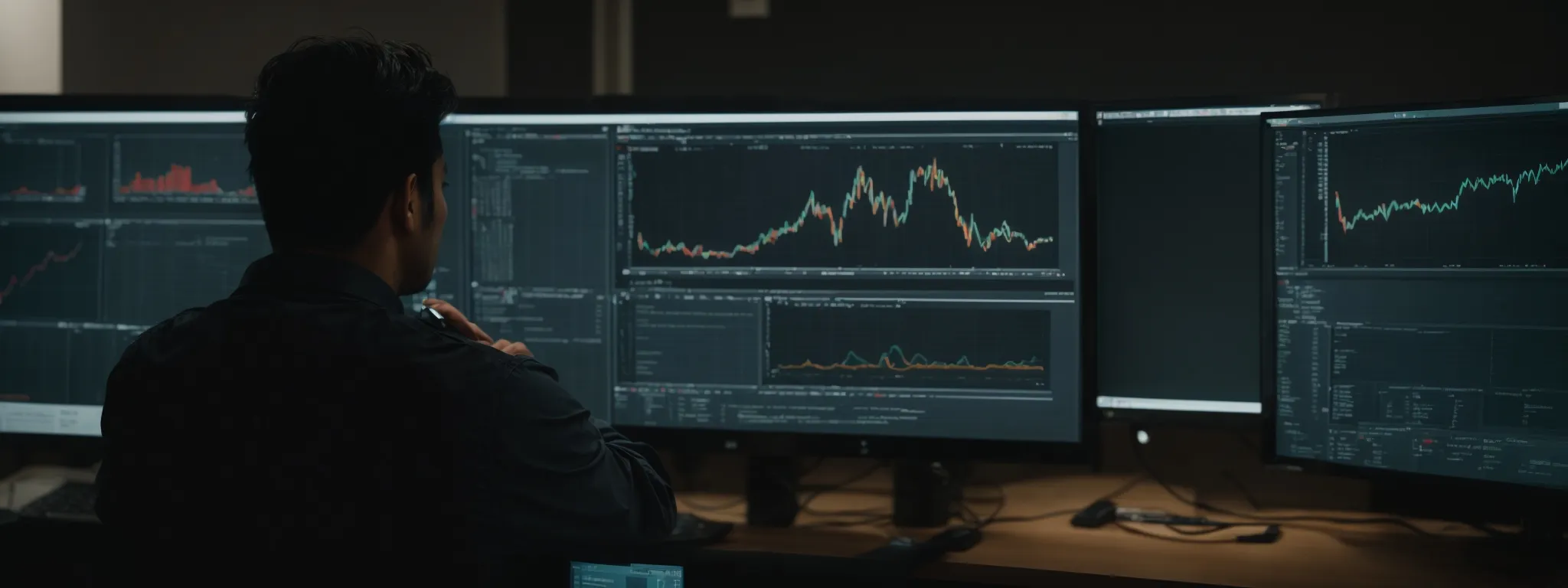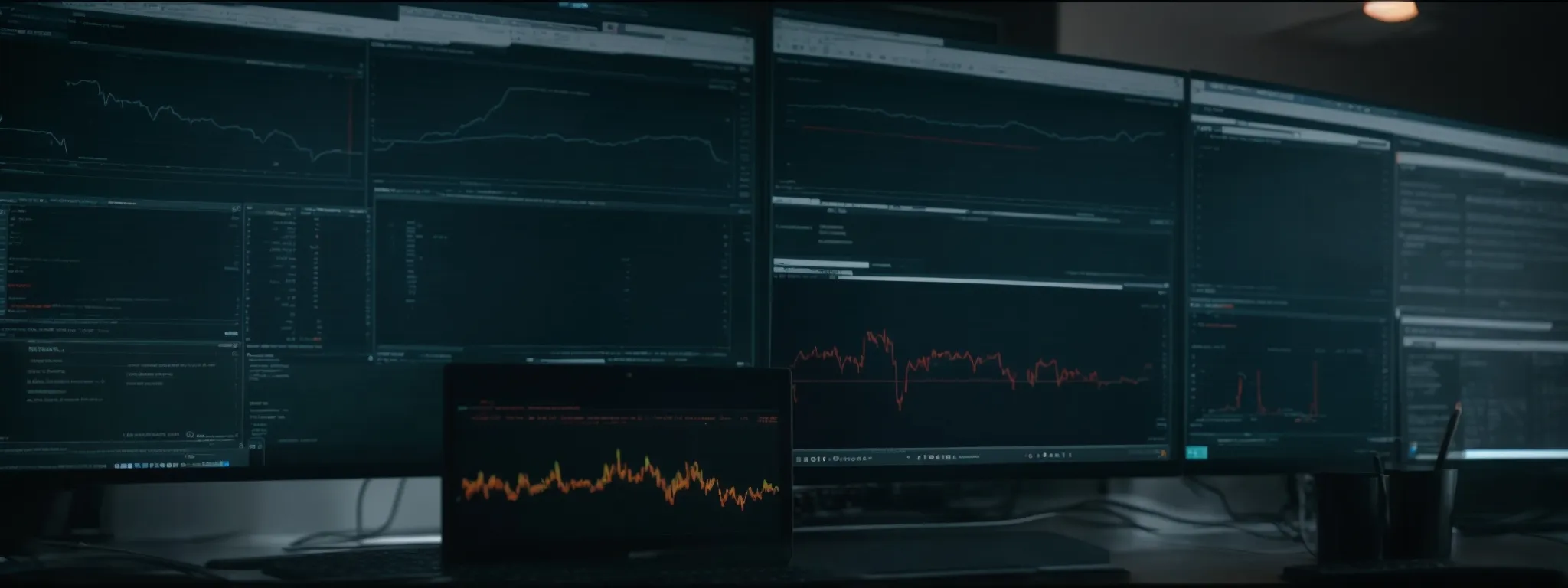SEO Issues: Rankings Dropped
Troubleshooting SEO Issues: Why Your Rankings Dropped When website owners notice a decline in their Google rankings, it often triggers an immediate concern over potential SEO issues. […]
Troubleshooting SEO Issues: Why Your Rankings Dropped
When website owners notice a decline in their Google rankings, it often triggers an immediate concern over potential SEO issues.
The causes can range from algorithm updates to overlooked on-page elements, affecting both new and established sites.
It’s imperative for one to analyze a multitude of factors, as they can all yield insights into the elusive culprits behind a ranking drop.
Detailing the right investigative steps and recovery strategies can make the difference between enduring a minor setback and facing a significant loss in search visibility.
Keep reading for a thorough examination of SEO pitfalls and tactical approaches offered by LinkGraph’s SEO services to bolster your website’s resilience in the face of shifts in search engine algorithms.
Key Takeaways
- A Comprehensive Examination of SEO Factors Is Critical for Diagnosing Ranking Declines
- LinkGraph Utilizes Advanced Tools and Services to Address and Recover From SEO Penalties and Ranking Drops
- Staying Vigilant in Monitoring Google Algorithm Changes and Adjusting SEO Strategies Is Essential for Maintaining Search Engine Standings
- Analyzing and Optimizing on-Page SEO Elements Like Meta Tags, Content, and URL Structure Is Instrumental in Improving Search Rankings
- Continuous Monitoring and Refinement of Implemented SEO Strategies Is Key to a Successful Recovery From Penalties
Initial Steps to Diagnose Sudden Ranking Drops

In the quest for superior online visibility, a sudden drop in search engine rankings can be disconcerting for any website owner.
The perplexing nature of SEO issues often requires a meticulous investigation to discover the root cause of a decline.
Professionals begin their diagnostic process by examining the possibility of Google algorithm updates, which can turn the tide for search engine landscapes overnight.
Secondly, scrutiny extends towards identifying any potential penalties or manual actions imposed that could hinder a site’s performance.
Alongside, it is imperative to validate any notices in Google’s Search Console that may indicate underlying concerns.
Analysis of search traffic data is another vital step, providing insights into specific fluctuations and trends.
Finally, it is crucial to scrutinize any recent website changes that could have inadvertently impacted search rankings.
This thorough multi-step audit is pivotal in formulating an effective response strategy.
Check for Google Algorithm Updates
A vigilant eye on Google’s algorithm alterations stands as a fundamental aspect of diagnosing SEO problems. Detecting these shifts is crucial because they can profoundly affect keyword positions and, consequently, search visibility.
LinkGraph’s SEO experts often leverage state-of-the-art tools like SearchAtlas SEO software to monitor and adapt to these updates swiftly, ensuring client websites maintain or improve their search engine standing amidst the changing digital landscape.
Confirm Penalties or Manual Actions
The specter of website penalties looms large for website owners faced with declining SEO rankings. Operators and SEO agencies alike must be vigilant, consulting Google Search Console for notifications of manual actions, which serve as the search giant’s way of flagging practices that contravene its guidelines. These notices are critical, as penalties can drastically reduce a site’s visibility, necessitating immediate remedial action.
Addressing such sanctions, LinkGraph’s SEO services encompass a systematic approach, navigating through the maze of recovery. Their seasoned experts are adept at identifying the infractions causing the penalties and executing the right steps to petition for penalty removal. Quick resolution of these SEO issues is imperative to reinstating previous search engine standings and mitigating the impact on web traffic and conversions.
Verify Search Console for Notices
A proactive examination of Google’s Search Console is a cornerstone practice for those managing SEO. Notifications here can often illuminate the causes behind a dip in rankings, whether from crawl errors, security issues, or harmful links pointing to the domain.
Diligence in this arena can prevent prolonged SEO ranking drops, as the Search Console acts as a direct line of communication from Google. Swift attention to alerts allows for a prompt and appropriate response:
- Reviewing messages on security issues or malware detection
- Responding to alerts of an increase in server errors or URL not found errors
- Analyzing data on manual penalties and formats of structured data issues
LinkGraph’s SEO services emphasize the critical role of this resource, integrating regular Search Console audits into their comprehensive SEO strategy to ensure ongoing search engine compliance and performance stability for their clients.
Inspect Changes in Search Traffic Data
An in-depth review of search traffic data often reveals nuanced insights that can guide SEO experts in pinpointing the source of a ranking drop. LinkGraph harnesses these data sets, utilizing advanced analytics to detect patterns related to a decline, such as decreased user engagement or altered search behaviors on various devices.
LinkGraph’s Adept Analysis of traffic fluctuations aids in isolating specific pages or keywords affected by changes in search ranking. This critical assessment facilitates a targeted approach to address declines directly, lending to strategic adjustments in SEO tactics to recover and enhance online prominence.
Review Recent Website Changes
When addressing search engine ranking difficulties, experts consider recent amendments to a client’s website as potentially impactful factors. A misstep as minor as tweaking the body content or the inadvertent alteration of metadata can trigger fluctuations in search visibility.
These changes are often scrutinized during comprehensive free SEO audits, a service where LinkGraph excels. Website alterations are methodically assessed to ensure they align with an optimal SEO content strategy:
- Evaluating modifications to title tags, meta descriptions, or headers for SEO impact
- Assessing the effect of new web pages or content revisions on search ranking
- Analyzing structural website updates, including navigation changes and URL redirects
In this rigorous evaluation, the team at LinkGraph employs meticulous scrutiny to link updates with search performance outcomes. This ensures that every adjustment adheres to best practices in on-page SEO services and contributes positively to the client’s overall search engine presence.
Identifying Technical SEO Problems Behind Ranking Drops

Within the labyrinth of technical SEO, a myriad of hidden obstacles can precipitate a startling descent in search rankings.
The diagnosis of a decline often necessitates a surgical examination of website functionality that influences search engine algorithms and user experience alike.
Professionals must thoroughly analyze key technical elements, such as site speed and performance, to ensure swift loading times which are essential for user retention and search ranking.
Similarly, adapting to the mobile-first indexing approach by Google makes assessing mobile usability a priority for any SEO strategy.
Equally, verifying the implementation of secure connections through SSL certificates is critical for not only providing a safe browsing experience but also for maintaining trust with search engines.
Lastly, canonical tags and redirects demand careful inspection to prevent detrimental impacts on site authority from issues like duplicate content or broken links.
This technical audit paves the way for rectifying technical SEO problems that may contribute to ranking declines, setting the stage for recovery and search optimization.
Analyze Site Speed and Performance Issues
Analyzing site speed and performance emerges as a vital factor when unraveling the complexities of SEO issues that could lead to ranking drops. LinkGraph’s white-label SEO services offer meticulous evaluation tools, like SearchAtlas SEO software, to measure website loading times and provide actionable insights that can boost page performance and user satisfaction.
Given search engines’ emphasis on user experience, slothful site speed not only dampens user engagement but also adversely affects search rankings. The SEO experts at LinkGraph prioritize this aspect, optimizing elements such as image sizes, server response times, and caching policies to foster an optimized online experience that aligns with the expectations of both search engines and users.
Evaluate Mobile Usability Concerns
Mobile usability has become a paramount factor for successful SEO as search engines increasingly prioritize mobile-friendly pages. The team at LinkGraph meticulously analyses a client’s website for mobile responsiveness, ensuring that content is easily accessible and navigable on all devices, thus protecting the site from potential ranking penalties associated with mobile usability issues.
LinkGraph’s commitment to optimal mobile performance involves thorough examinations of page elements, such as touch screen readiness and page load speed on smartphones and tablets. Their SEO experts leverage this focus on mobile optimization to enhance user experience and support a site’s ability to compete effectively in today’s mobile-centric online marketplace.
Check for Secure Connection Problems (SSL)
Secure connections via SSL (Secure Socket Layer) certificates have become an intrinsic requirement for websites aiming for high search engine rankings. LinkGraph takes SSL implementation seriously, diagnosing the SSL configurations of client websites to ensure encryption standards are met, thereby maintaining the integrity of the connection between the user’s browser and the website, a critical factor that search engines reward with higher rankings.
In the event of an SEO ranking drop, LinkGraph’s investigation often includes a thorough examination of SSL certificates, detecting any issues that may interrupt a secure user experience and erode search engine trust. Their experts swiftly rectify such problems, restoring encrypted connections which are imperative not only for user security but also for sustaining and improving a website’s standing in Google search results.
Inspect Canonical Tags and Redirects
Canonical tags and redirects serve as central navigational signals for search engines, effectively guiding Googlebot through a mosaic of site content. LinkGraph’s rigorous inspection of these elements ensures that they accurately reflect the intended destinations, thus preserving the integrity of a site’s link equity and preventing issues such as content duplication from diluting a site’s SEO strength.
In the face of declining google rankings, LinkGraph delves into a forensic analysis of canonicalization and the implementation of HTTP redirects. Anomalies in these areas, such as improper use of the rel=”canonical” link element or faulty redirects leading to 404 errors, can lead to a muddled site hierarchy and hinder search engine rankings:
- Assessing the precision of canonical tags in distinguishing between similar web pages
- Validating the proper execution of 301 redirects to ensure seamless user and search engine navigation
- Evaluating temporary 302 redirects that, if misused, can inadvertently impact page authority
Content Issues That Might Affect Your SEO Performance

Content remains a cornerstone of SEO performance, its quality and relevance critical to maintaining and enhancing search engine rankings.
As website owners navigate through the complexities of SEO, comprehending how content influences their site’s visibility is essential.
LinkGraph’s on-page SEO services meticulously evaluate content, ensuring it resonates with both search engines and a discerning audience.
Maintaining vigilance over keyword rankings, refreshing outdated material, and fine-tuning the internal linking architecture are all pivotal in preserving the ever-crucial Google trust and consumer satisfaction.
This deep dive into content health forms the bedrock for sustainable online success.
Assess the Quality of Your Web Content
In assessing web content quality, LinkGraph’s Meticulous Approach incorporates a thorough examination of topical relevancy, lexical richness, and user engagement metrics to ensure alignment with search intent.
LinkGraph’s team scrutinizes on-page factors, including title relevance and meta descriptions, guaranteeing that content not only satisfies search queries but also drives higher click-through rates (CTR), securing enhanced search visibility for clients.
Monitor Keyword Rankings for Variations
Constant vigilance in monitoring keyword rankings is a fundamental practice within LinkGraph’s suite of SEO services. Their SEO experts actively track keyword variations, utilizing the advanced rank tracker capabilities of SearchAtlas SEO software to quickly identify shifts that could signal underlying SEO issues or changes in competitor strategies.
LinkGraph recognizes that even minor fluctuations in keyword positions can have a considerable impact on search traffic and overall search engine visibility. Addressing these variations promptly allows their team to refine SEO tactics, ensuring that clients sustain their competitive edge in the digital marketplace.
Update Outdated Content to Remain Relevant
In the dynamic arena of search engine optimization, the freshness of site content functions as a barometer for relevance. LinkGraph’s SEO content strategy embraces the continual refreshment of web articles, infusing them with up-to-date information, ensuring websites cling to the forefront of SERPs and retain their appeal to modern consumers.
Stale content poses a critical threat to the perceived value of a website in the scrutinizing eyes of both Google’s algorithm and discerning users. The professionals at LinkGraph are adept at crafting updated content that aligns with evolving search intent, preserving the vitality of the site’s offerings and fortifying its search engine positioning for the long term.
Review Your Internal Linking Strategy
An internal linking strategy is crucial for directing search engine crawlers to discover the depth and breadth of content a site offers. LinkGraph’s Tactical Assessment ensures that every link serves a purpose, bolstering the site’s navigational structure and distributing page authority effectively across the domain.
Optimizing internal links involves strategic anchor text selection and link placement that enhances user experience and content discoverability. By employing such meticulous practices, LinkGraph ensures a cohesive and robust internal linking framework, contributing to sustained SEO strength and improved search engine rankings for their clients.
The Impact of Backlinks on Search Engine Rankings

The linchpin of a website’s authority in search engine rankings often pivots on the robustness of its backlink profile.
A sudden downturn in a site’s search visibility can sometimes be traced back to disruptions within this crucial ecosystem.
Professionals tasked with troubleshooting SEO pitfalls must turn a critical eye towards the stability and quality of backlinks.
Investigating lost or broken backlinks is an initiation into this intricate exploration.
An examination of the caliber of recently acquired backlinks follows closely, as their influence on rankings is significant.
Further, the audit must encompass anchor text diversity and relevance — a subtle yet powerful aspect of link efficacy.
Lastly, understanding the competitive landscape is incomplete without delving into the link-building efforts of rival domains.
Each of these facets combines to form a detailed picture of how backlinks impact a site’s stature within the algorithmic judgments of search engines.
Investigate Lost or Broken Backlinks
Recognizing the sway that backlinks hold over a site’s reputation, LinkGraph conducts a thorough analysis to uncover any lost or broken links that may undermine SEO efforts. Their white-label link building services incorporate sophisticated methods and SearchAtlas SEO software to trace backlinks across the web, pinpointing disruptions in a site’s backlink landscape, which could signal a need for immediate corrective action.
LinkGraph’s examination of backlink integrity empowers website owners to restore lost links that previously contributed to their domain authority. By addressing these deficiencies proactively, LinkGraph’s SEO experts work diligently to maintain the cohesive strength of a site’s external link profile, ensuring it remains a solid pillar supporting the weight of the site’s search engine rankings.
Examine the Quality of New Backlinks
LinkGraph’s expertise extends to a scrupulous evaluation of newly acquired backlinks, as these can profoundly influence a website’s ranking trajectory. Their seasoned professionals employ advanced tools to disentangle the quality of each backlink, discerning whether they emanate from reputable sources and if they uphold the stringent standards needed to bolster a site’s authority.
With meticulous attention to detail, the experts at LinkGraph assess the relevance and context of new backlinks, ensuring they are congruent with the website’s niche and contribute positively to the search engine’s perception of the site’s credibility. This vigilant monitoring ensures that clients’ backlink profiles are continually optimized for peak performance in search rankings.
Audit Anchor Text Diversity and Relevance
An integral component of a robust SEO strategy lies within auditing anchor text diversity and relevance. LinkGraph’s meticulous approach to backlink analysis delves into the specifics of anchor texts, recognizing that the right mix of generic, branded, and keyword-rich variations can significantly sway a site’s relevance and authority in the eyes of search engines.
By conducting a thorough audit, LinkGraph ensures that anchor texts not only reflect the topical nature of the linked content but also avoid over-optimization, which can trigger red flags for algorithmic penalties. The goal is to cultivate a natural and diverse backlink profile that contributes positively to the website’s search rankings:
| Anchor Text Category | Relevance | Diversity Score | Impact on SEO |
|---|---|---|---|
| Branded | High | Low | Strong |
| Generic | Medium | High | Moderate |
| Keyword-Rich | Variable | Medium | Variable |
Understand the Role of Competitors’ Link-Building
In the competitive realm of SEO, understanding how rival companies conduct their link-building efforts is not just insightful; it’s a strategic imperative. LinkGraph’s SEO professionals analyze competitor backlinks to ascertain strategies that may be affecting their clients’ standings in search results.
This competitor analysis includes gauging the strength and relevance of backlinks competitors have gained. Insights from this evaluation aid LinkGraph’s team in crafting nuanced link-building strategies that not only match but surpass the competition’s scope and impact:
| Competitor | Number of Backlinks | Domain Authority of Backlinks | Link Acquisition Rate |
|---|---|---|---|
| Competitor A | 2,500 | High | Steady |
| Competitor B | 1,500 | Medium | Aggressive |
| Competitor C | 3,000 | Low | Slow |
How User Experience Influences SEO Rankings

In the dynamic world of SEO, observing fluctuations in rankings often leads to a vital conversation about the user’s digital journey.
Insights into how individuals interact with a web page inform the relationship between user experience and search engine rankings—a narrative that examines metrics beyond mere keywords and backlinks.
Professionals zero in on bounce rates and engagement metrics, scrutinize the user interface and experience design, and dissect user behavior flows to garner a holistic understanding.
These elements carry significant weight in determining a site’s appeal to both users and search engines, ultimately shaping the trajectory of a website’s visibility in search results.
Track Bounce Rate and User Engagement Metrics
LinkGraph’s comprehensive approach to SEO performance encompasses a keen analysis of bounce rates and user engagement metrics. These indicators offer insight into how effectively a website is capturing and retaining visitor interest, vital elements that influence search rankings and the potential for conversions.
By actively monitoring these key metrics, the SEO professionals at LinkGraph can identify patterns in user behavior that signal the efficacy of the site’s user experience, informing strategic refinements that enhance overall site performance and search engine placement.
Evaluate UI/UX Design for Usability Concerns
The examination of a website’s user interface (UI) and user experience (UX) design plays an essential role in diagnosing the root causes behind SEO ranking decreases. LinkGraph’s SEO professionals meticulously evaluate UI/UX components, ensuring that visual and navigational aspects of a website facilitate smooth user journeys and align with SEO best practices.
Usability concerns such as confusing navigation, slow page loading, and non-intuitive design elements can significantly deter a positive user experience, thereby impacting a website’s standing in search engine results. By actively addressing these issues, LinkGraph upholds the usability standards expected by modern web users and search engines alike:
- Identifying areas where users struggle to interact with the site
- Streamlining navigation to foster an intuitive user flow
- Optimizing visual elements to reduce load times and enhance engagement
Analyze User Behavior Flows for Insights
Analyzing user behavior flows yields indispensable insights into how visitors navigate and interact with a website, highlighting pathways that contribute to a robust SEO strategy. LinkGraph’s refined assessment interprets these behavior patterns, revealing opportunities to optimize the website structure and content to better meet user needs and search engine criteria.
These analyses shed light on potential bottlenecks within the site that may be contributing to increased bounce rates and lowering search engine rankings:
- Pinpointing where users typically exit the site can indicate underperforming content or user experience issues.
- Evaluating the conversion funnel’s effectiveness helps in understanding where improvements can be made to guide users to the desired action.
- Assessing the flow between pages provides insights into internal link structure optimization to boost SEO performance.
By deploying such deep analyses, LinkGraph ensures that clients benefit from an SEO perspective that privileges both user satisfaction and compliance with search engine algorithms, thereby bolstering their online presence effectively.
On-Page Optimization Factors to Revisit

As the online landscape becomes increasingly competitive, pinpointing and resolving on-page SEO factors that affect a website’s search engine rankings is more crucial than ever.
On-page elements, such as meta tags, structured data, URL structures, and image attributes, play a pivotal role in conveying the relevancy and quality of content to search engines.
A proficient review of these factors by SEO experts, like those at LinkGraph, can reveal opportunities for optimization, ensuring that each webpage is meticulously calibrated to perform at its peak within the search engine results pages (SERPs).
For website owners seeking to comprehend and recover from ranking declines, revisiting and refining these essential on-page factors is an indispensable step in restoring their digital presence.
Verify Meta Tags and Descriptions
Ensuring that meta tags and descriptions are accurate and effective is a key step in troubleshooting SEO issues. These HTML elements provide vital information to search engines, summarizing a page’s content and influencing how it is presented in search results.
Overlooked and suboptimal meta tags can lead to a misrepresentation of a site’s content, resulting in unsatisfactory user engagement and a decline in search rankings:
- Correctly implemented title tags contribute to the relevance of a webpage for targeted search queries.
- Meta descriptions should encapsulate the essence of the page content, enticing users to click through from the search engine results page.
Optimize Page Headings and Structured Data
Optimizing page headings is pivotal for clarifying the hierarchy and focus of content for both users and search engines. LinkGraph’s on-page SEO services meticulously craft H1, H2, and subsequent subheadings to ensure they are descriptive, incorporate target keywords, and guide the reader’s journey through the page, thus solidifying content relevance and supporting improved search rankings.
Concurrently, structured data plays an instrumental role in enhancing search engine understanding and aiding rich snippet appearances in search results. By diligently implementing and testing structured data markup, LinkGraph enables search engines to parse content with greater efficacy, directly influencing how information from a website is indexed and displayed, which can be a determinative factor in recovering from google rankings drops.
Standardize URL Structures for Consistency
In the eyes of search engines, the clarity of a website’s URL structure is a subtle yet potent indicator of the content’s organization and relevance. Professionals at LinkGraph recognize the compelling value of uniform URL structures, ensuring that each website address is meticulously curated to promote clarity and enhance search engine indexation, a crucial consideration for recovering from a google ranking drop.
Maintaining a consistent approach to URL formatting, including proper use of slugs, adherence to a logical hierarchy, and avoidance of unnecessary parameters, can significantly impact a site’s SEO performance. LinkGraph’s SEO experts meticulously align URL structures with an overarching SEO content strategy, refining each aspect to optimize the site for search engines’ crawling and indexing capabilities.
Ensure Image Alt Text Is Properly Utilized
Proper utilization of image alt text stands as a crucial yet frequently underestimated aspect of on-page optimization. It plays a significant role in interpreting visual content for both users who rely on screen readers and search engine crawlers that index the images.
An oversight in this seemingly minor detail can impede a website’s accessibility and its potential to rank well in image searches:
- Descriptive alt text should concisely convey the content and function of the image for improved search relevance.
- Incorporating relevant keywords in alt text can enhance a webpage’s SEO while maintaining context authenticity.
- SEO experts at LinkGraph systematically ensure that each image alt attribute adheres to these best practices, fortifying a website’s on-page SEO structure.
Reversing the Impact of a Google Penalty

For businesses and website owners, witnessing a dip in search engine rankings can be alarming and may indicate the imposition of a Google penalty.
Determining the nature of this punitive measure is the first step in initiating a successful recovery.
Companies must embark on a methodical sequence of actions, beginning with the exact identification of the penalty, be it algorithmic or manual.
LinkGraph’s SEO professionals tailor a cohesive recovery plan aligned with Google’s stringent guidelines and best practices to combat the decline.
When manual action is involved, a well-documented reconsideration request becomes pivotal.
Throughout this remedial journey, continuous monitoring ensures that recovery strategies are dynamically adjusted, providing the website with the best chance to regain its previous search prominence.
Identify the Type of Google Penalty Incurred
Navigating the complexities of a Google penalty requires prompt identification of the infringement type to expedite recovery strategies. LinkGraph’s seasoned experts distinguish between algorithmic penalties, typically triggered by updates that change ranking criteria, and manual actions, imposed directly by Google when it detects non-compliant practices.
Crucial to this diagnostic process is the utilization of Google Search Console, where LinkGraph’s professionals meticulously search for notifications indicating a manual action. The distinction provides a clear direction for the remediation process, where algorithmic penalties demand an overall strategy change, whereas manual actions require detailed scrutiny and specific responses.
Formulate a Recovery Plan With Best Practices
Devising a resilient recovery plan anchored in SEO best practices is tantamount to mitigating the consequences of a Google penalty. LinkGraph Leverages Its Comprehensive SEO Expertise to create tailored recovery strategies that adhere to Google’s evolving guidelines, ensuring that corrections made are precise and conducive to a swift restoration of rankings.
LinkGraph’s approach involves a thorough reassessment of the affected website’s SEO practices and the deployment of white-hat tactics to address the specific issues flagged by Google. This bespoke recovery plan is executed with a clear focus on transparency and sustainability, positioning the website for a robust comeback in the SERPs.
Submit a Reconsideration Request if Needed
In the event that a website incurs a manual action from Google, LinkGraph’s protocol includes the crafting and submission of a reconsideration request. This critical communication must articulate the changes implemented to rectify the contraventions of Google’s guidelines, outlining the steps taken to cleanse the site of any infractions.
LinkGraph’s expertise in such matters ensures that the reconsideration request is not only thorough but also reflective of a sincere and committed effort towards compliance. Their professional involvement aims to convey the remedial actions in a manner that facilitates the lifting of penalties, thereby aiding in the restoration of the client’s search rankings.
Monitor Recovery Progress and Adjust Strategy
After implementing a recovery strategy following a Google penalty, diligent monitoring is critical to assess the effectiveness of the corrective measures taken. LinkGraph’s SEO professionals meticulously observe ranking changes, traffic patterns, and user behavior to gauge the progress of the recovery efforts.
Continuous adaptation forms the backbone of a successful SEO recovery; as data is collected, LinkGraph’s strategy is re-evaluated and refined to align with the dynamic nature of search engine algorithms and the website’s evolving needs:
- Interpreting analytics to discern the recovery trajectory and make data-driven decisions.
- Adjusting SEO techniques and content strategies to bolster ongoing improvement.
- Measuring the return on investment to ensure the recovery plan remains cost-effective.
This proactive approach equips LinkGraph’s clients with the agility to respond to shifting search landscape requirements, firmly securing their return to favorable rankings in the search engine results pages.
Conclusion
Troubleshooting SEO issues is critical when confronting sudden drops in search engine rankings, an event that can significantly affect online visibility and traffic.
The importance of a meticulous investigative process, such as the one employed by LinkGraph, cannot be overstated.
Starting with checking for Google algorithm updates, assessing penalties, verifying notices in Search Console, and analyzing search traffic data, the process pinpoints the root of the decline.
Additionally, reviewing recent website changes, technical SEO problems like site speed, mobile usability, secure connections, and canonical tags ensures the website remains optimized and compliant with Google’s standards.
Further, evaluating the quality and strategy of content, including the assessment of backlinks for losses or quality issues, auditing anchor text diversity, and understanding the competition’s link-building strategies, remains paramount.
Moreover, understanding the user experience, including metrics like bounce rates, UI/UX designs, and user behavior flows, informs how to enhance site appeal to search engines and users alike.
On-page factors, from meta tags to structured data and image alt text, require constant optimization.
In cases where Google penalties incur ranking drops, identifying the type of penalty is key, followed by formulating and executing a recovery plan aligned with best practices.
If necessary, submitting a well-documented reconsideration request can help to lift manual actions.
Lastly, monitoring the recovery progress and adjusting strategies is essential for SEO resilience and the assurance of enduring search prominence.














































































